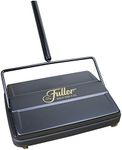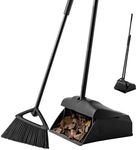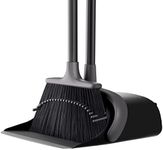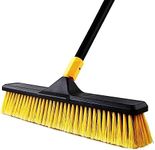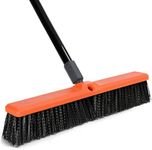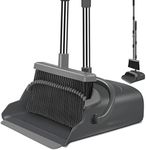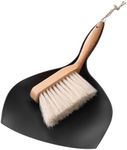Buying Guide for the Best brooms
Choosing the right broom can make a significant difference in how efficiently and effectively you can clean your space. The right broom for you will depend on the type of surfaces you need to clean, the kind of debris you typically encounter, and your personal preferences for handle length and broom head design. Here are some key specifications to consider when selecting a broom, along with explanations to help you make the best choice for your needs.Bristle MaterialThe bristle material of a broom is crucial because it determines how well the broom can pick up different types of debris and how durable it will be. Common bristle materials include natural fibers, synthetic fibers, and rubber. Natural fibers, like corn or horsehair, are great for sweeping fine dust and dirt on smooth surfaces. Synthetic fibers, such as nylon or polypropylene, are more durable and can handle rougher surfaces and larger debris. Rubber bristles are excellent for picking up pet hair and can be used on both wet and dry surfaces. Choose a bristle material based on the type of debris you usually need to clean and the surfaces you will be sweeping.
Bristle StiffnessBristle stiffness affects how well a broom can handle different types of debris and surfaces. Soft bristles are ideal for sweeping fine dust and dirt on smooth, indoor surfaces like hardwood or tile floors. Medium-stiff bristles are versatile and can be used on both indoor and outdoor surfaces, handling a variety of debris types. Stiff bristles are best for outdoor use, as they can sweep up larger debris like leaves and gravel on rough surfaces like concrete or asphalt. Consider the typical cleaning tasks you perform and choose a bristle stiffness that matches those needs.
Broom Head SizeThe size of the broom head determines how much area you can cover with each sweep. Smaller broom heads are more maneuverable and can easily reach into tight spaces, making them ideal for indoor use in smaller rooms or around furniture. Larger broom heads cover more ground with each sweep, making them more efficient for cleaning large, open areas like garages, driveways, or large rooms. Think about the size of the areas you need to clean and choose a broom head size that will allow you to clean efficiently without sacrificing maneuverability.
Handle LengthThe length of the broom handle affects your comfort and ease of use. A handle that is too short can cause you to bend over while sweeping, leading to back strain. A handle that is too long can be unwieldy and difficult to control. Standard broom handles are typically around 48 inches long, which is suitable for most people. However, if you are particularly tall or short, you may want to look for a broom with an adjustable handle or one that is specifically designed for your height. Choose a handle length that allows you to sweep comfortably without straining your back or arms.
Broom ShapeBrooms come in various shapes, including flat, angled, and push broom designs. Flat brooms are traditional and work well for general sweeping tasks. Angled brooms have bristles cut at an angle, making it easier to reach into corners and along edges, which is great for indoor use. Push brooms have wide heads and are designed for pushing debris in large, open areas, making them ideal for outdoor use or large indoor spaces like warehouses. Consider the specific areas you need to clean and choose a broom shape that will help you reach all the nooks and crannies or cover large areas efficiently.



